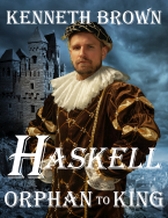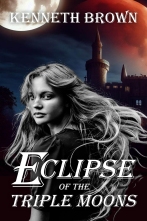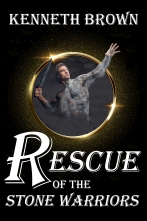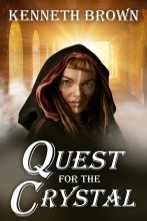Adgitize Press
Dialogue in Scenes
By: Ken Brown
Published: 7/4/2019
This is a continuation on a series of writing stronger scenes for a talk I gave at my local library to the young adults. In this article I talk about dialogue as action, dialogue as suspense and dialogue and a character's past.
Using Dialogue to Enhance Your Scene
Dialogue is a great way to create suspense and action. Wait, dialogue as action? Let’s go back to happy people in happy land. You have two people sitting at a kitchen table and their dialogue goes something like this:
Dialogue as Action
Sally said, “I’m going to the store for the party, do you want anything?
Bill said, “Your family likes the chips, the ranch and onion flavored ones.”
“Okay, and I’m getting a birthday card for Uncle George.”
Sounds like there’s a party for Uncle George. But this is boring dialogue, when one person says something and the next person responds in an appropriate way. But, that doesn’t move our story forward. There’s no conflict. No hidden motives. No action. Try this instead.
Sally said, “I gotta get out here.”
Bill said, “Where are you going?”
“Wherever I want. You’re not my boss.”
“You better not be going to the store again. We have plenty of food for Uncle George’s party. Your family can do without the extra bag of potato chips. This party’s going to put us in debt, we can’t afford more food. And don’t get more pop for your brother, Steve, he drank a six pack by himself last time. He can have one glass of pop and then drink water.”
This is dialogue as action. The reader wonders what's going to happen next, will Sally get the cake and extra potato chips? Will Bill go ballistic on her and doing something at the party to embarrass Sally or make Uncle George uncomfortable? The reader is willing to read more to find out and won't put the book down even though it's an hour past his bedtime.
Dialogue as Suspense
Dialogue can be useful to open a scene with suspense or to foreshadow events that heighten suspense. Start a scene off with dialogue by having the character ask a question. Let’s say we have a dragon terrorizing a kingdom and we start a scene this way.
“Do you think the dragon will return?” Sally asked and stepped closer to David.
"No, that dragon will never fly over our skies again," David sheaved his sword and turned his horse toward the castle.
From this point on in the scene you can add information about other characters, give us more setting, and foreshadow events that might happen. But the whole time the reader is thinking, the writer wouldn’t have started the scene that way unless the dragon is coming back. Every paragraph where the dragon doesn’t return means that the reader’s heartrate is rising. She knows the dragon is coming back. The protagonist has his back turned away from the mountains, is the dragon sneaking back unseen?
A favorite author of mine, Robert Jordan, who wrote the Wheel of Time series has a chapter that starts with the heroine touching a black eye tenderly and a character saying, “Whoa, that black eye is a beauty.” As a reader I’m thinking, wait, a black eye, I don’t remember that happening in the previous chapter. Then the master writer tells us about some of the people in the story who needed to be introduced and gives us more information about the setting.
Every tenth or twentieth paragraph or so he brings up the black eye again and gives us a little more information about how she got the black eye. Not the full story, just hints. Finally four thousand words later the reader knows the whole story. And we got a ton of useful character set up and setting all while worried about how the heroine got the black eye.
Match Dialogue to a Character’s past.
When you are writing a novel set in the fifteen hundreds or even the nineteen fifties, you need to make sure that you use appropriate metaphors. Imagine your character is a high school student living in the Midwest from the nineteen fifties and the building she’s in is rocking back and forth because of a rare earthquake. You can’t say, Sally felt the building swaying reminding her of swaying on a cruise ship over large waves. Chances are good that Sally has never been on a cruise ship.
What’s a young shepherd from the middle Ages going to think something reminds him of compared to a high school student from today? A blacksmith will say the heat felt like pouring hot molten metal from the forge. A housewife from the nineteen fifties will compare meals differently as opposed to a modern city dweller with a microwave and a number of fast food restaurants in the neighborhood.
Dialogue Tags
What’s a dialogue tag? That’s the use of Sally said or he said or Bill asked. These you should definitely use when you’re writing dialogue. But you should also use other attribution tags.
Bill shouted at Carl, “You better run!”
Sally stared wide-eyed at Carl fleeing, “He’s an evil man.”
Bill held her hand, “You don’t have to be afraid any longer.”
“Do you think he will return?” She wiped away a tear streaming down her cheek. She placed her head on his shoulder and he embraced her.
“You’re safe now.”
You can use he said, and she said, and she asked. Use the attribution tag at the start of the sentence if we don't know who's talking. Once we find out who's talking then feel free to add the tag to the end of the sentence or even poke it halfway through the dialogue. If it is a long sentence or paragraph then use the tag early in case the reader thinks it's someone else talking and then has to re-read the paragraph to make sense of the dialogue.
Using Dialogue Tags with Purpose
Once we know who’s talking then you can get rid of attribution tags. To speed up a section don’t use any attribution tags other than the first two to show us who’s talking. To slow it down, give us commentary, or thoughts or what the character is doing. During the Conflict scene use little attribution tags or use them only to show what action a character is performing that will add to the conflict or heighten the suspense.
Then during the sequel scene, use more dialogue tags and give us more of the character’s thoughts. I hope this gets you using the tags with purpose not just randomly assigning tags because someone said you should.
Use Dialogue like a Boxing Match
Your dialogue should be like a fencing match or a boxing match. No straight answers. Sally has a goal and an agenda. Bill has a goal and an agenda. They are not the same agenda and require them to answer questions with answers that serve their best interest or to spar by asking the other person a question.
“How did you get in here?” the security guard asked.
“Who’s asking?”
“Come on I have to escort you out.” He grabbed my arm.
I ripped my arm away, “There’s someone I need to see.”
The best writers will make this uncomfortable scene last way past the point most people will have given up and left the building. But the good writers keep it up. Why? To show character or to squeeze out a little more information about the plot or setting. Or to set up a viewpoint of theme. Make your dialogue have conflict and don’t release the tension too soon.
Quote by Raymond Obstfeld
An argument doesn’t end when someone makes a witty or stinging comment; it keeps on going to the point where people are uncomfortable, frustrated, at a loss for words. So must the scene.
-
Things to watch for when writing dialogue.
- Too many dialogue tags
- Too few tags
- Tag lines in the wrong place
- Tag lines with too much information
- Bland or melodramatic tags
A key is to have characters whose cadence and tone of voice is unique enough that you can write a whole scene without tag lines and know who is talking. (Please don’t do this. Use some tag lines.) But if you are wondering if all your characters sound alike then remove all attribution tags in a scene and see if you can tell who is talking.
Keep tag lines simple. The more complex the tag lines, the more it detracts from the actual dialogue. Avoid adverbs with “ly” endings like angrily, loudly, hotly, quickly …. If your dialogue is right then you don’t need the tag. Say the dialogue out loud to see if it’s realistic. Make your dialogue fresh and unique reflecting each individual’s character.
Recent Blog Articles
Full Moon Snow Covered Backyard
My Current Projects October 2020
Make Your Settings Do Double Duty
Understanding the Scene Process
What is a Scene Purpose or Focus
The Reaction Scene or Sequel Scene
What are the Building Blocks of a Novel
Your Writing Effort is Front Loaded
What I Learned from Reading Lee Child Books
Six Reasons to Describe Your Characters




